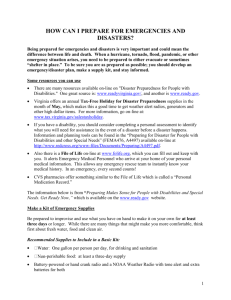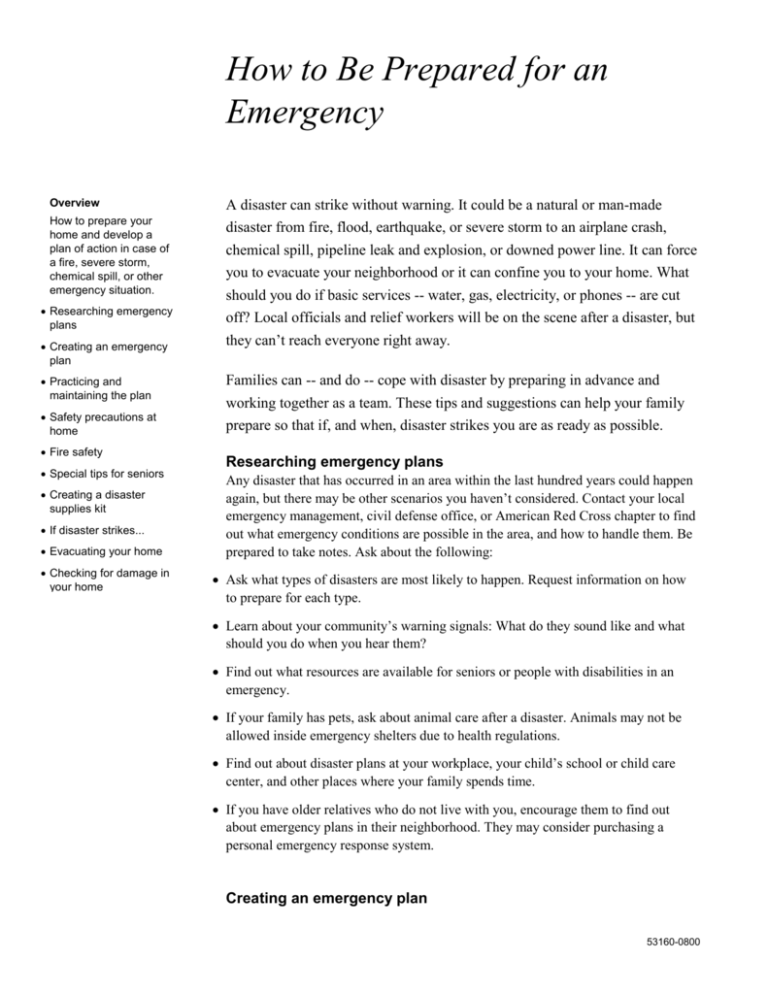
How to Be Prepared for an
Emergency
Overview
How to prepare your
home and develop a
plan of action in case of
a fire, severe storm,
chemical spill, or other
emergency situation.
Researching emergency
plans
Creating an emergency
plan
Practicing and
maintaining the plan
Safety precautions at
home
Fire safety
Special tips for seniors
Creating a disaster
supplies kit
If disaster strikes...
Evacuating your home
Checking for damage in
your home
A disaster can strike without warning. It could be a natural or man-made
disaster from fire, flood, earthquake, or severe storm to an airplane crash,
chemical spill, pipeline leak and explosion, or downed power line. It can force
you to evacuate your neighborhood or it can confine you to your home. What
should you do if basic services -- water, gas, electricity, or phones -- are cut
off? Local officials and relief workers will be on the scene after a disaster, but
they can’t reach everyone right away.
Families can -- and do -- cope with disaster by preparing in advance and
working together as a team. These tips and suggestions can help your family
prepare so that if, and when, disaster strikes you are as ready as possible.
Researching emergency plans
Any disaster that has occurred in an area within the last hundred years could happen
again, but there may be other scenarios you haven’t considered. Contact your local
emergency management, civil defense office, or American Red Cross chapter to find
out what emergency conditions are possible in the area, and how to handle them. Be
prepared to take notes. Ask about the following:
Ask what types of disasters are most likely to happen. Request information on how
to prepare for each type.
Learn about your community’s warning signals: What do they sound like and what
should you do when you hear them?
Find out what resources are available for seniors or people with disabilities in an
emergency.
If your family has pets, ask about animal care after a disaster. Animals may not be
allowed inside emergency shelters due to health regulations.
Find out about disaster plans at your workplace, your child’s school or child care
center, and other places where your family spends time.
If you have older relatives who do not live with you, encourage them to find out
about emergency plans in their neighborhood. They may consider purchasing a
personal emergency response system.
Creating an emergency plan
53160-0800
2
How to Be Prepared for an Emergency
Hold a family meeting to discuss why the family needs to prepare for disaster.
Explain the dangers of fire, severe weather, earthquakes, and other emergencies to a
child using understandable terms. Explain that establishing a plan makes it more
likely that the family will stay together in an emergency. Plan to share
responsibilities and work as a team.
Discuss the types of disasters that are most likely to happen. Explain what to do in
each case.
Arrange for a buddy system where each person in a pair protects the welfare of the
other person in an emergency.
Pick two places to meet:
- right outside the home in case of a sudden emergency, such as a fire
- outside the neighborhood in case a family member is at work or school and can’t
return home. Everyone should know the address and phone number of the meeting
place.
Ask an out-of-state friend or family member to be a “family contact.” After a local
disaster, it’s often easier to call long distance. Other family members should call the
family contact person and tell him where you are. Everyone must know the contact’s
phone number. It’s a good idea for family members to carry a small card that lists the
meeting places, addresses, and the family contact information on it. You can keep
the card in a wallet or bag.
Discuss what to do in an evacuation. Plan how to take care of pets.
Discuss what to do about power outages and personal injuries.
Find the safe spots in your home for each type of disaster.
Post emergency telephone numbers by phones (fire, police, ambulance, etc.).
Teach children how and when to call 911 or local Emergency Medical Services for
help.
Show each family member how and when to turn off the water, gas, and electricity at
the main switches. Keep necessary tools near gas and water shut-off valves.
(Remember that once the gas is off, you must wait for a professional to turn it back
on.)
Check to make sure the family has sufficient insurance coverage.
Teach each family member how to use the fire extinguisher (A-B-C type), and show
them where it is.
Have a battery-powered radio ready. Instruct household members to turn on the radio
for emergency information.
Stock emergency supplies and assemble a disaster supplies kit and car emergency kit.
3
How to Be Prepared for an Emergency
Take a basic first aid and CPR class.
Draw a floor plan of your home to determine the best escape routes. Find two ways
out of each room.
Practicing and maintaining the plan
Having a plan is only useful if you practice and maintain it. All systems should be in
working order and all family members should know what to do. To practice your
plan, do the following:
Quiz children every six months so they remember what to do.
Conduct fire and emergency evacuation drills every six months. Keep a log of the
dates of these drills.
Replace stored water every three months and stored food every six months.
Test and recharge fire extinguishers according to manufacturer’s instructions.
Test smoke detectors monthly and change the batteries at least once a year. (Check
monthly even if the smoke detectors use household currency and have an
automatically recharging backup battery.) Use a checklist or log to be sure these
tasks are completed.
Safety precautions at home
To help avoid an emergency situation in your home, do the following:
Check that electrical outlets aren’t overloaded.
Install smoke detectors on every level of the home, especially near bedrooms.
Purchase and learn how to use a fire extinguisher (5 lb., A-B-C type).
Use battery-operated night lights around your home -- especially near stairs and in
hallways.
Have flashlights and batteries available, along with a battery-powered radio.
Keep a whistle in each bedroom to awaken the household in case of fire.
Arrange furniture to provide obstacle-free passageways into rooms and hallways.
Make sure gas, electrical and plumbing fixtures and connections are in good repair;
if not, have a professional repair them. Do not allow an unqualified person to attempt
electrical, gas, or plumbing repairs.
Have a collapsible ladder on each upper floor of the home.
Exercise care when using candles; candles are one of the leading causes of house
fires.
4
How to Be Prepared for an Emergency
Instruct your children on the dangers of matches, candles, or any other flame source.
Fire safety
To help ensure your and your family’s safety in case of fire:
Teach family members to stay low to the ground when escaping from a fire.
Teach family members never to open hot doors. In a fire, feel the bottom of the door
with the palm of the hand. If it is hot, do not open. Find another way out.
Special tips for seniors
If an older adult lives alone, make sure she has an emergency escape plan. If she
lives with other relatives, she should have a copy of the plan in her room.
Have extra assistive devices, such as walking canes, handy in strategic areas around
the house.
Have ready at least a one month’s emergency supply of needed medications.
Creating a disaster supplies kit
You should keep enough supplies in your home to meet all basic needs for at least
three days. Assemble a disaster supplies kit with items you might need if you are
homebound or are forced to evacuate. Store these supplies in sturdy containers such
as backpacks, duffle bags, or covered trash containers. Prepare a smaller car
emergency supplies kit to be kept in the car trunk.
Supplies kit
A three-day supply of water (one gallon per person, per day) and food that won’t
spoil. Include a manual can opener, and pet food and supplies if applicable.
one change of clothing and footwear per person, and one blanket or sleeping bag per
person
a first aid kit that includes prescription medications
emergency tools including a battery-powered radio, flashlight, plenty of extra
batteries, and a utility knife
an extra set of car keys and a credit card, cash, or traveler’s checks
personal supplies (toilet paper, soap, toothbrush, etc.)
any special items or equipment for infant, older, or disabled family members
(formula, diapers, denture or eye care supplies, etc.)
an extra pair of eyeglasses
important family documents in a waterproof container
5
How to Be Prepared for an Emergency
Car emergency supplies kit
battery-powered radio, flashlight, and extra batteries
blanket
booster cables
fire extinguisher (5 lb., A-B-C type)
first aid kit and manual
bottled water and non-perishable, high-energy foods like granola bars and raisins
maps, shovel, flares
tire repair kit and pump
If disaster strikes. . .
Remain calm and patient. Put your plan into action.
Check for injuries and get help for seriously injured people.
Listen to a battery-powered radio for news and instructions. Evacuate, if advised to
do so.
Confine or secure pets.
Call the family contact, then don’t use the telephone again unless it’s a lifethreatening emergency.
Check on neighbors, especially older adults or people with disabilities.
Make sure there is an adequate water supply in case service is cut off.
Stay away from downed power lines.
Evacuating your home
In a severe emergency, you may need to evacuate your home. Be prepared to do the
following:
Listen to a battery-powered radio. Follow the instructions of local emergency
officials. Evacuate immediately if told to do so.
Wear protective clothing and sturdy shoes.
Take your disaster supplies kit.
Lock your home.
Use travel routes specified by local authorities. Don’t use shortcuts; certain areas
may be impassable or dangerous.
6
How to Be Prepared for an Emergency
If there is time,
Shut off water, gas, and electricity before leaving, if instructed to do so.
Post a note telling others when the family left and where you are going.
Make arrangements for pets.
Checking for damage in your home
After an emergency occurs, check right away for damage:
Use flashlights -- do not light matches or turn on electrical switches if you suspect
damage.
Check for fires, fire hazards, broken glass, and other household hazards.
Sniff for gas leaks, starting at the hot water heater. If someone smells gas or suspects
a leak, turn off the main gas valve, open windows, and get everyone outside quickly.
Shut off any other damaged utilities.
Clean up spilled medicines, bleaches, gasoline, and flammable liquids immediately.
The suggestions listed above include basic information to help you design an
emergency or disaster response system. You can also obtain more information from
your local government office of emergency services, fire departments, American Red
Cross, National Weather Service, Federal Emergency Management Agency, local
utility companies, and local public libraries.
Adapted from Federal Emergency Management Agency publications on disasters and
preparedness.
© 1998, 2000 Ceridian Corporation. All rights reserved.

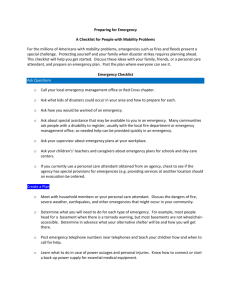
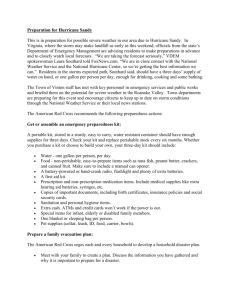
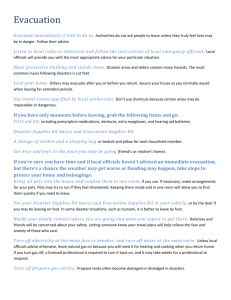

![Emergency Preparedness Checklist []](http://s3.studylib.net/store/data/007578463_2-030b7bdf6b3f06db2ba816477f51565c-300x300.png)



